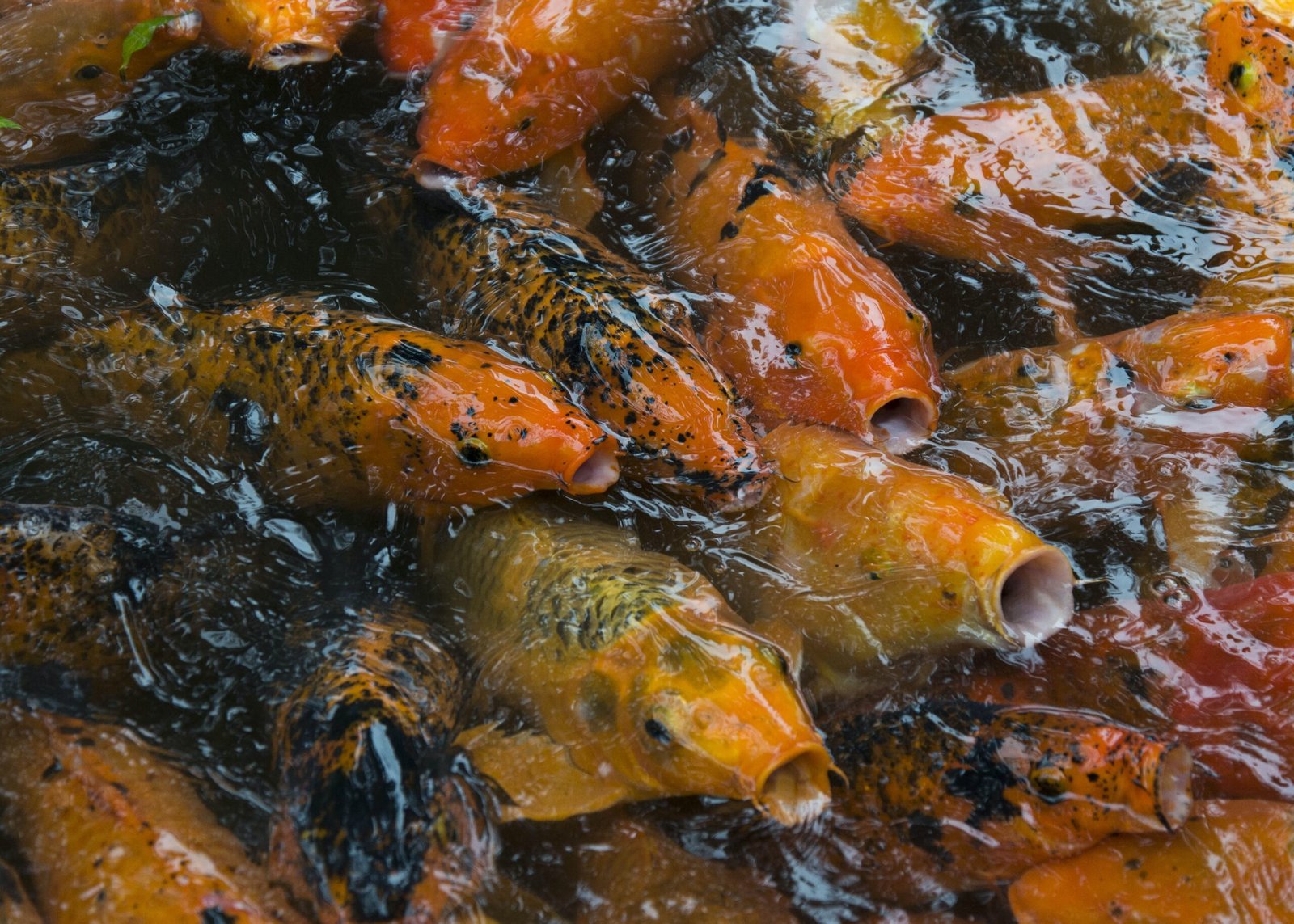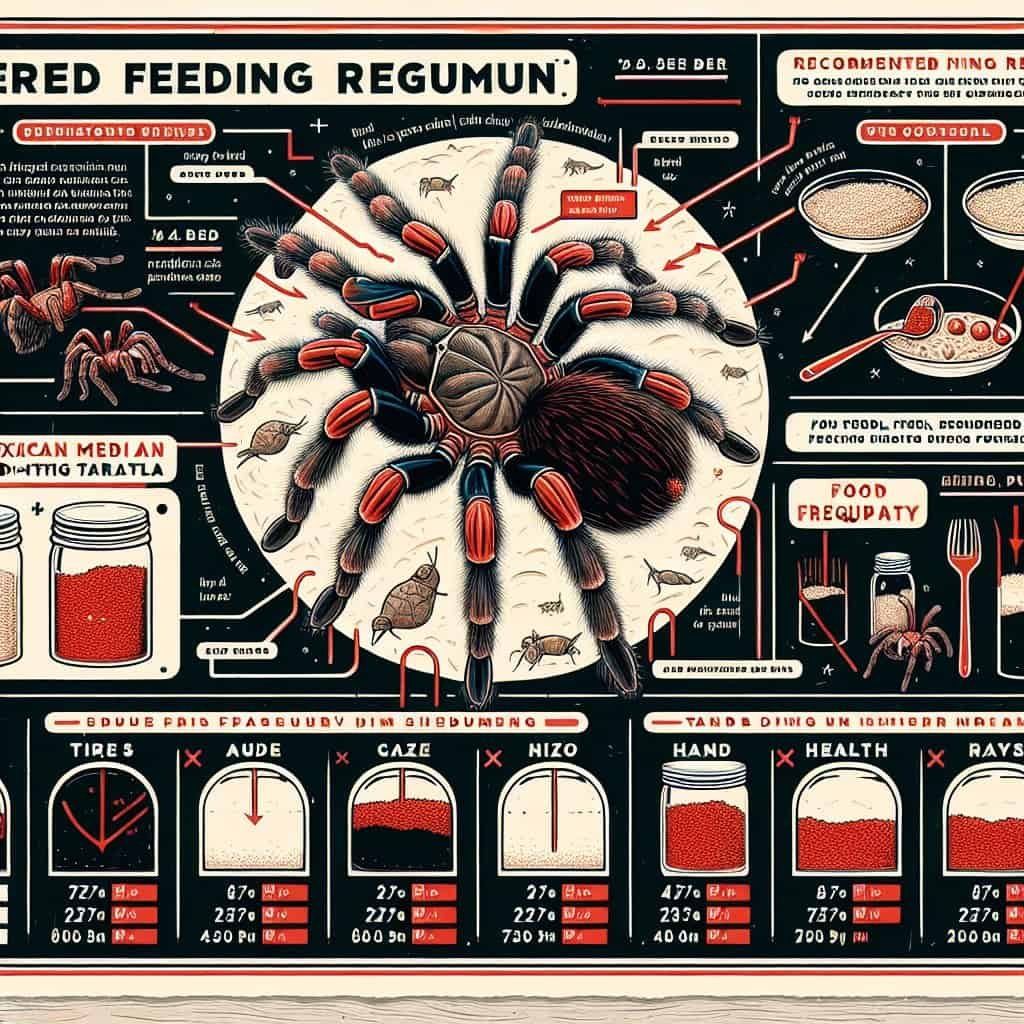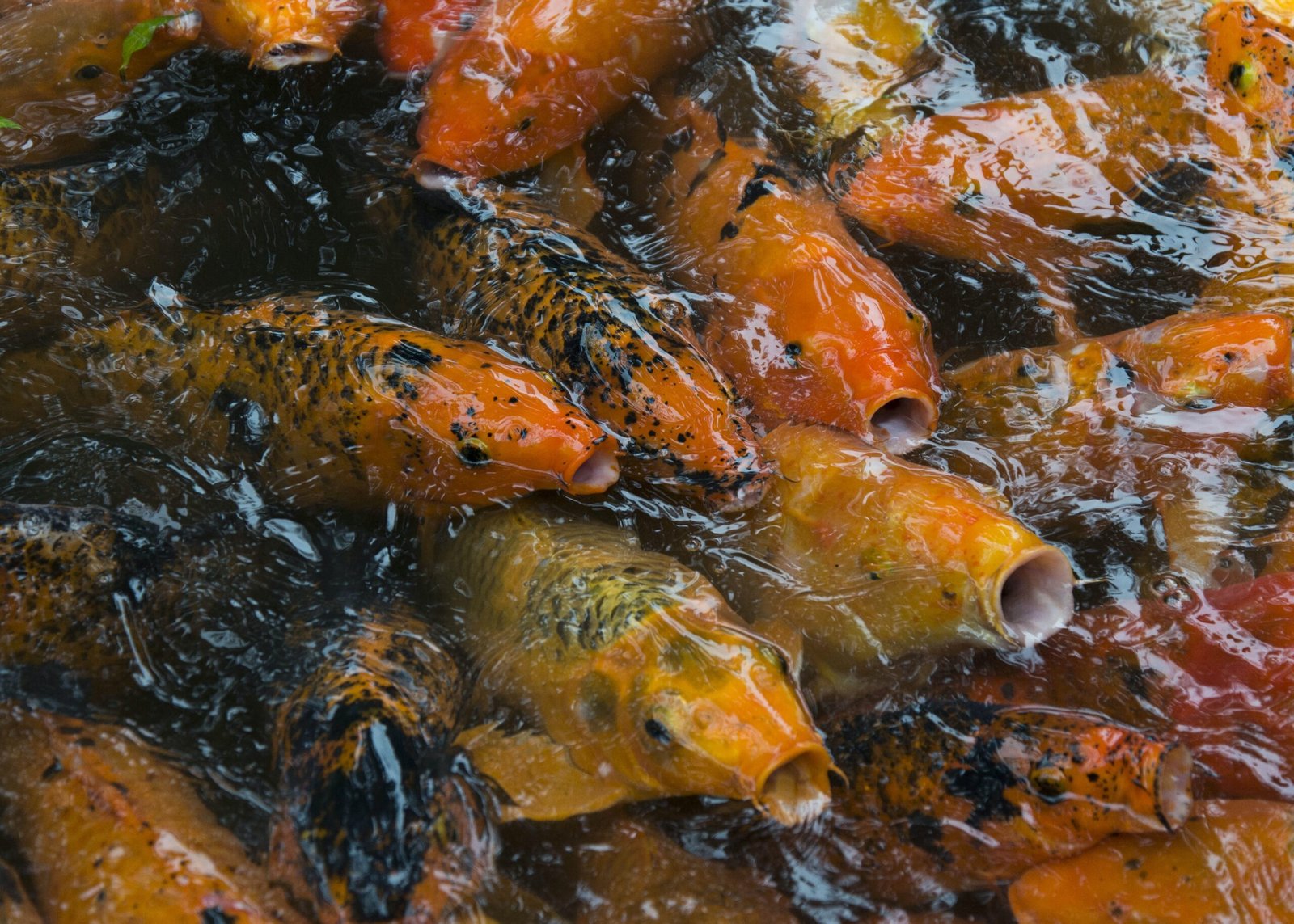Are you a proud owner of a Mexican red-legged tarantula? If so, you might be wondering about the best way to keep your eight-legged friend well-fed and happy. Understanding the feeding regimen for these fascinating creatures is essential to their overall health and well-being. In this article, we will explore the ideal diet for the Mexican red-legged tarantula and provide guidance on how often you should offer them food. So, let’s jump right in and ensure your tarantula remains a content and well-nourished companion.

Feeding Habits of Mexican Red-legged Tarantula
Carnivorous Diet
The Mexican Red-legged Tarantula, also known as the Brachypelma smithi, follows a carnivorous diet in the wild. As an arachnid, it relies on obtaining nutrients and energy from animal prey, mainly insects. While some tarantulas have been known to occasionally consume small vertebrates, their primary source of food is insects.
Insects as the Primary Prey
Insects make up the vast majority of the Mexican Red-legged Tarantula’s diet. These arachnids have a strong preference for live insects, as they rely on the prey’s movement to stimulate their hunting instincts. Commonly offered insects include crickets, roaches, mealworms, and waxworms. These insects serve as a rich source of protein and other essential nutrients for the tarantula’s overall health and survival.
Variety of Prey Options
Introducing a variety of prey options is beneficial for the Mexican Red-legged Tarantula’s diet. Different insects offer varying nutritional values, minerals, and vitamins. By offering diverse prey, you can ensure your tarantula receives a well-rounded diet. However, it is crucial to consider the appropriate size of the prey to prevent any potential harm to your tarantula during feeding.
Avoid Feeding Wild Insects
Feeding your Mexican Red-legged Tarantula with wild-caught insects may pose several risks. Wild insects can carry parasites, diseases, or may have been exposed to pesticides. To ensure the health and safety of your tarantula, it is best to opt for commercially bred insects specifically for feeding purposes. These insects are usually free from any potential contaminants and are a reliable source of nutrition.
Feeding Frequency Based on Age
The frequency of feeding for Mexican Red-legged Tarantulas varies depending on their age. Understanding your tarantula’s age is essential to establish an appropriate feeding schedule and avoid overfeeding or underfeeding.
Frequency for Juvenile Tarantulas
For juvenile Mexican Red-legged Tarantulas, daily feeding is recommended. Young tarantulas are in a crucial growth phase and require regular nutrition to support their development. It is important to monitor their appetite and feeding response to ensure they are receiving adequate nourishment. As they mature, you can gradually transition them to less frequent feedings.
Frequency for Adult Tarantulas
As the Mexican Red-legged Tarantula reaches adulthood, its feeding frequency can be decreased. Biweekly or triweekly feedings are suitable for adult tarantulas. By this stage, they have reached their optimum size and do not require as much food as they did during their juvenile stage. However, it is still crucial to observe their body condition and weight to ensure they maintain a healthy appearance.
Monitoring Appetite and Body Condition
Regularly monitoring your Mexican Red-legged Tarantula’s appetite and body condition is crucial in maintaining its health. Visual observations can give you insights into whether your tarantula is being fed appropriately. A healthy tarantula should have a plump abdomen, indicating that it has consumed enough food. Be cautious of signs of overfeeding, such as excessive weight gain or a distended abdomen, as it can lead to health issues. Conversely, signs of underfeeding can include a visibly thin body and decreased activity.
Recommended Prey Size
When selecting prey for your Mexican Red-legged Tarantula, it is vital to consider its size. The prey should be approximately three-quarters of the tarantula’s leg span. Choosing prey that is too large may cause difficulties during feeding, leading to potential injuries. On the other hand, prey that is too small may not provide sufficient nutrition. It is important to strike a balance and choose prey that is proportionate to your tarantula’s size.
Water Requirements
Providing access to fresh water is essential for the Mexican Red-legged Tarantula’s overall well-being. Place a shallow water dish in the enclosure, making sure it is accessible but not too deep to prevent drowning. Clean and refill the water dish regularly to maintain hygiene. Additionally, tarantulas have the ability to utilize moisture for molting, a crucial process in their growth and development. Proper hydration ensures a successful molting process and maintains the tarantula’s health.
Carnivorous Diet
Natural Diet Characteristics
The Mexican Red-legged Tarantula’s natural diet is characterized by its carnivorous nature. These arachnids have evolved to be effective predators, relying on animal protein to meet their nutritional needs. Their diet primarily consists of insects, although they have been known to occasionally consume small vertebrates in the wild.
Importance of Animal Protein
Animal protein is crucial for the Mexican Red-legged Tarantula’s growth, development, and overall health. It provides essential amino acids necessary for muscle development, cell repair, and other physiological processes. Without an adequate supply of animal protein, tarantulas may suffer from malnutrition and weakened immune systems. Therefore, it is essential to prioritize animal protein as the primary component of their diet.
No Vegetarian Options
Unlike some other creatures, the Mexican Red-legged Tarantula does not have any vegetarian options. Their digestive systems are not equipped to process plant matter. They lack the necessary enzyme, amylase, to break down complex carbohydrates found in plants. Therefore, it is crucial to ensure a consistent supply of animal prey to meet their nutritional requirements.
Role of Tarantula Venom in Predation
Tarantulas possess venom that aids in hunting and predation. Although they are not considered medically significant to humans, their venom plays a crucial role in immobilizing and digesting their prey. Once injected into the prey’s body, the venom breaks down their tissues, making it easier for the tarantula to consume. Without their venomous capabilities, tarantulas would struggle to subdue and feed on their live prey.
Insects as the Primary Prey
Preference for Live Insects
Mexican Red-legged Tarantulas have a strong preference for live insects as their primary prey. They rely on the movement and vibrations of their prey to stimulate their hunting instincts. Live insects provide the tarantula with a more natural hunting experience, allowing them to exhibit their natural predatory behavior. Therefore, it is recommended to offer live insects whenever possible to ensure the tarantula’s optimal feeding experience.
Commonly Offered Insects
Several insects are commonly offered as prey for the Mexican Red-legged Tarantula. Crickets, roaches, mealworms, and waxworms are some popular choices. These insects are nutritionally dense and readily available in pet stores or from reputable online suppliers. It is important to ensure that these insects are gut-loaded, meaning they have been properly fed nutritious diets themselves before being offered to the tarantula.
Avoid Toxic Prey
It is crucial to avoid offering toxic prey to the Mexican Red-legged Tarantula. Some insects, such as fireflies and certain beetles, produce toxins that can be harmful or even deadly to tarantulas. It is essential to research and familiarize yourself with the potential toxicity of different insect species before introducing them as prey. Prioritize the safety and well-being of your tarantula by ensuring it is not exposed to any toxic substances.
Digestive System Adaptations
The Mexican Red-legged Tarantula has unique adaptations in its digestive system that allow it to successfully consume and process prey. They possess specialized mouthparts, such as fangs and chelicerae, that aid in capturing and immobilizing their prey. Once bitten, tarantulas inject their venom, which contains digestive enzymes, into the prey. The venom begins breaking down the prey’s tissues, allowing the tarantula to consume it more easily. This efficient digestive process ensures that the tarantula can extract maximum nutrition from its prey.
Variety of Prey Options
Introducing Variety in Feeding
Introducing a variety of prey options in your Mexican Red-legged Tarantula’s diet can be beneficial for its overall health. Different insect species offer varying nutritional profiles, ensuring a more balanced diet for your pet. By offering varied prey options, you can provide a mix of proteins, fats, vitamins, and minerals that meet your tarantula’s dietary needs.
Benefit of Including Different Insects
Incorporating different insects into your tarantula’s diet has several advantages. Each insect species possesses unique nutrients and minerals that contribute to the tarantula’s overall well-being. For example, crickets are a good source of protein, while mealworms are high in fat. By offering a variety of insects, you can ensure your tarantula receives a well-rounded and diverse nutrient intake.
Consideration for Prey Size and Nutritional Value
When introducing a variety of prey options, it is crucial to consider their size and nutritional value. Prey should be appropriately sized for your tarantula, as offering prey that is too large can lead to difficulties during feeding. Additionally, it is important to consider the nutritional value of each insect species and ensure that your tarantula’s diet remains balanced. By selecting prey options carefully, you can provide a diet that meets all of your tarantula’s nutritional requirements.

Avoid Feeding Wild Insects
Risks of Wild Caught Prey
Feeding your Mexican Red-legged Tarantula with wild-caught insects carries several risks. Wild insects may have been exposed to pesticides or herbicides, which can be toxic to tarantulas. Additionally, they could be carrying parasites or diseases that can harm your pet. Feeding wild-caught insects to your tarantula increases the likelihood of introducing harmful contaminants into its enclosure, potentially leading to health issues.
Pesticide Contamination
Wild insects have a higher chance of being exposed to pesticides and other chemicals used in agriculture or gardening practices. These pesticides can pose serious risks to your tarantula’s health when consumed. Commercially bred insects are typically raised in controlled environments and are not subjected to pesticide exposure, making them a safer option for feeding your tarantula.
Parasites and Diseases
Wild insects can carry parasites and diseases that are harmful to your tarantula. These parasites may infect your pet, leading to a weakened immune system, loss of appetite, or other health complications. By feeding commercially bred insects, you can significantly reduce the risk of introducing parasites or diseases into your tarantula’s enclosure.
Quarantine for Newly Caught Insects
If you do choose to feed your tarantula wild insects, it is essential to quarantine them before introducing them as prey. Quarantining the insects allows you to observe them for any signs of disease or parasites. It also ensures that any potential toxins are eliminated from their system before being consumed by your tarantula. Quarantine should ideally last for several weeks to ensure the health and safety of your tarantula.
Feeding Frequency Based on Age
Importance of Knowing Tarantula’s Age
Determining the age of your Mexican Red-legged Tarantula is crucial for establishing an appropriate feeding schedule. Feeding frequency varies depending on the tarantula’s age, as younger tarantulas have different growth requirements compared to adults. Knowing your tarantula’s age allows you to tailor its feeding regimen to ensure optimal health and development.
Frequency Adjustments for Growth
Younger tarantulas are in a phase of rapid growth and require more frequent feeding to support their development. As they mature, their growth rate slows down, and their nutritional requirements change. Adjusting the feeding frequency based on your tarantula’s age ensures that it receives the necessary nutrients during different stages of its life.
Factors Affecting Feeding Schedule
Several factors can influence the feeding schedule for your Mexican Red-legged Tarantula. These include the tarantula’s age, size, metabolism, and overall health. It is essential to consider these factors when determining the feeding frequency. Regular monitoring of your tarantula’s appetite, weight, and body condition can help you make necessary adjustments to its feeding schedule.

Frequency for Juvenile Tarantulas
Daily Feeding for Young Tarantulas
Juvenile Mexican Red-legged Tarantulas require daily feedings due to their rapid growth and higher metabolic rate. Providing daily meals ensures they receive a consistent supply of nutrients that support their development. Offering a variety of appropriately sized live insects on a daily basis helps meet their nutritional needs and promotes healthy growth.
Monitoring Appetite and Feeding Response
When feeding juvenile tarantulas, it is important to monitor their appetite and feeding response. Active and enthusiastic feeding is a positive sign that your tarantula is healthy and thriving. However, a decrease in appetite or a lack of interest in food may indicate health issues or the beginning of a molt. Regular observation allows you to identify any changes in their feeding behavior and address them promptly.
Gradual Transition to Less Frequent Feedings
As your Mexican Red-legged Tarantula matures, you can gradually transition it to less frequent feedings. This process allows its metabolic rate to adjust and prevents overfeeding. Once your tarantula reaches adulthood, you can establish a biweekly or triweekly feeding schedule. However, always be mindful of your tarantula’s appetite and body condition to ensure it remains healthy and well-fed.
Frequency for Adult Tarantulas
Decrease in Feeding Frequency
Adult Mexican Red-legged Tarantulas require a decrease in feeding frequency compared to their juvenile counterparts. This adjustment is necessary as their growth rate has significantly slowed down, and their nutritional requirements have changed. Overfeeding adult tarantulas can lead to obesity and potential health problems, so it is crucial to provide an appropriate feeding schedule that matches their age and activity level.
Biweekly or Triweekly Feedings
For adult tarantulas, a feeding schedule of biweekly or triweekly feedings is generally sufficient. Offering a variety of appropriately sized live insects during these feedings ensures they receive their required nutrients without overindulging. It is important to observe their body condition and weight to ensure they are maintaining a healthy appearance and not becoming overweight.
Observing Body Condition and Weight
Observing your adult Mexican Red-legged Tarantula’s body condition and weight is crucial when determining its feeding frequency. Ideally, the tarantula should have a well-rounded abdomen without appearing excessively bloated or distended. If you notice signs of overweight or obesity, such as difficulties in movement or lethargy, it may be necessary to adjust the feeding frequency to prevent further health issues.
Adjustments for Breeding Females
Breeding females require special consideration when it comes to their feeding schedule. In preparation for egg production, they may require more frequent and larger meals to supply the necessary resources for their reproductive process. Once their eggs are laid, their feeding schedule should return to a regular feeding regimen to prevent overfeeding or potential complications.

Monitoring Appetite and Body Condition
Visual Observations
Visual observations play a crucial role in monitoring your Mexican Red-legged Tarantula’s appetite and body condition. Regularly checking on your tarantula allows you to assess its overall health and make any necessary adjustments to its feeding schedule. By observing their feeding behavior and physical appearance, you can address any potential issues promptly, ensuring their well-being.
Healthy Weight and Appearance
A healthy Mexican Red-legged Tarantula should maintain a balanced weight and appearance. It should have a plump and well-rounded abdomen, indicating that it has consumed an appropriate amount of food. Additionally, its legs should appear sturdy, and its movements should be agile and coordinated. These visual cues are indicators of a tarantula that is properly fed and in good overall health.
Signs of Overfeeding or Underfeeding
Monitoring your Mexican Red-legged Tarantula’s appetite and body condition helps identify signs of overfeeding or underfeeding. Overfeeding can lead to obesity, which can strain the tarantula’s internal organs and impact its mobility. Signs of overfeeding include an overly distended abdomen, lethargy, and difficulties in movement. On the other hand, an underfed tarantula may have a visibly thin body, decreased activity, and a lack of appetite. Proper monitoring allows you to make necessary adjustments to ensure your tarantula remains healthy.
Water Requirements
Providing Access to Fresh Water
Providing access to fresh water is essential for the Mexican Red-legged Tarantula’s well-being. Although tarantulas do not drink water in the same way mammals do, they still require access to it for various physiological processes. Place a shallow water dish in the tarantula’s enclosure, making sure it is accessible but not too deep to prevent drowning. Ensure the water dish is cleaned and refilled regularly to maintain cleanliness.
Water Dish Placement and Maintenance
The placement of the water dish is crucial to ensure your tarantula’s safety. It should be positioned in a location where it won’t be easily tipped over or contaminated by substrate or waste. Placing the water dish away from the tarantula’s hide or web ensures that it remains clean and accessible. Regularly clean the water dish to prevent the growth of bacteria or other harmful microorganisms.
Utilization of Moisture for Molting
Water also plays a vital role during the molting process of Mexican Red-legged Tarantulas. Before molting, tarantulas require increased humidity levels to facilitate the shedding of their old exoskeleton. By providing access to fresh water, you ensure that your tarantula can utilize moisture to enhance the molting process. Proper hydration during molting is crucial for the successful shedding of the old exoskeleton and the emergence of a healthy, new one.
In conclusion, the feeding habits of the Mexican Red-legged Tarantula follow a carnivorous diet predominantly consisting of live insects. It is crucial to offer a variety of prey options to ensure a balanced diet that meets their nutritional needs. Feeding frequency should be adjusted based on age, with daily feedings for juveniles and biweekly or triweekly feedings for adults. Regular monitoring of appetite, body condition, and water requirements is essential to maintaining the health and well-being of your tarantula. By providing the appropriate prey size and following proper feeding practices, you can ensure that your Mexican Red-legged Tarantula thrives in captivity.

